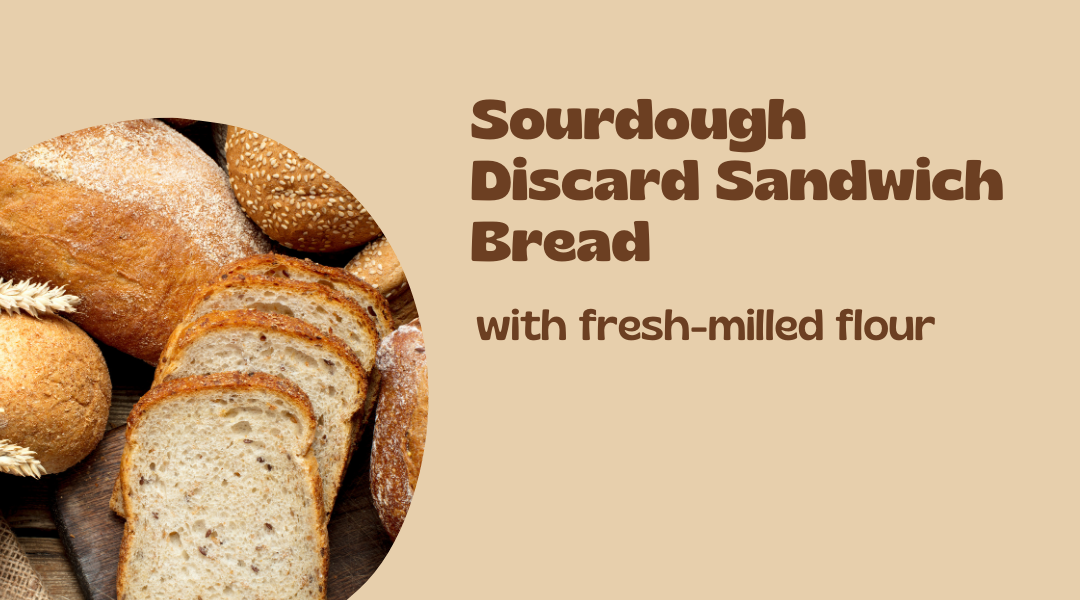If you’ve been baking with sourdough, you know the challenge of finding creative ways to use up sourdough discard. This sourdough discard sandwich bread recipe is a delicious solution—and it gets even better when made with fresh-milled flour.
Not only is this bread soft, fluffy, and perfect for sandwiches, but it’s also packed with the health benefits of fresh-milled grains. From improved nutrition to incredible flavor, baking with freshly ground flour takes homemade bread to the next level.
Why Use Fresh-Milled Flour?
Using fresh-milled flour isn’t just trendy—it’s a game-changer for your health and the taste of your bread. Here’s why:
-
Nutrient-Rich
Freshly ground flour retains the bran and germ, which are rich in vitamins, minerals, and healthy fats. Store-bought flours often lose these nutrients during processing and shelf storage. -
Improved Digestion
Fresh flour contains natural enzymes that aid digestion, especially when paired with sourdough discard, which is naturally fermented. -
Better Flavor
Fresh-milled grains bring out the full, nutty, and earthy flavors of the wheat, making your bread taste fresher and more vibrant. -
Low-Tox Benefits
Commercial flours sometimes contain additives or preservatives. Fresh-milled flour is pure, simple, and free from unwanted chemicals. -
Sustainability
Grinding your own flour reduces packaging waste and supports a sustainable, low-tox lifestyle.
Sourdough Discard Sandwich Bread Recipe
Ingredients:
- 1 cup water, 236 grams
- 1 tablespoon honey, 21 grams
- 3 teaspoons active dry yeast, 9 grams
- 4 tablespoons butter, softened (57 grams)
- 4 cups fresh-milled flour, 560 grams
- 1/2 tablespoon salt, 8 grams
- 1 cup sourdough discard, 285 grams
Instructions:
1. Activate the Yeast
In a small bowl, whisk together warm water, honey, and yeast. Let it sit at room temperature for about 5 minutes until it becomes bubbly. This step ensures the yeast is active and ready to work.
2. Mix the Dough
Add the yeast mixture, butter, fresh-milled flour, salt, and sourdough discard to the bowl of a stand mixer fitted with a dough hook. Knead on low speed until the dough is smooth and elastic—about 10 minutes. You can also knead by hand, which may take longer.
3. Test for Gluten Development
To ensure your bread will be light and fluffy, perform the windowpane test. Take a small piece of dough, stretch it into a thin square, and see if you can see light through it without tearing.
4. Bulk Rise
Place the dough in a greased bowl and cover it with a lid, plastic wrap, or a towel. Let it rise for 1–2 hours in a warm place, such as on top of the refrigerator or near a sunny window, until it doubles in size.
5. Shape the Dough
Once risen, roll the dough flat into a rectangle. Roll it tightly into a loaf shape and pinch the ends to seal. Place the shaped dough into a greased or parchment-lined bread pan, seam side down.
6. Second Rise
Cover the dough with a towel and let it rise for 30 minutes to 1 hour, or until it doubles in size again.
7. Optional Egg Wash
For a golden, shiny crust, whisk an egg in a small bowl and brush it lightly over the top of the dough.
8. Bake
Preheat your oven to 375°F (190°C). Bake the loaf for about 45 minutes, or until the top is a beautiful golden brown.
9. Cool and Enjoy
Let the bread cool completely before slicing to maintain its texture. Store in an airtight container to keep it fresh.
Tips for Success
- Using Fresh-Milled Flour: Freshly ground whole wheat or spelt flour works beautifully in this recipe. For a lighter loaf, sift the flour to remove some of the bran.
- Don’t Skip the Rest Periods: Allowing the dough to rise properly ensures a fluffy, airy texture.
- Use Active Sourdough Discard: Discard that’s been recently fed will provide the best flavor and texture.
The Health Benefits of Homemade Sourdough Bread
Homemade sourdough discard bread made with fresh-milled flour isn’t just delicious—it’s a healthy addition to your diet. It’s free from artificial preservatives and loaded with natural nutrients from the whole grains. Plus, the sourdough fermentation process helps neutralize phytic acid, improving nutrient absorption.
Final Thoughts
Making your own sandwich bread from sourdough discard and fresh-milled flour is a rewarding experience. Not only do you get to enjoy the wholesome, rich flavors of homemade bread, but you also nourish your family with every slice.
Ready to start baking? Try this recipe today, and let me know how it turns out! For more tips and recipes, check out my Low-Tox Living Blog.
Looking for an easy way to eat healthy this winter? Grab my 7 Day Meal Plan for only $5! It has links to over 20 seasonal and nourishing recipes.
Need help finding low-tox ingredients? Check out my Walmart Storefront for my favorites!
